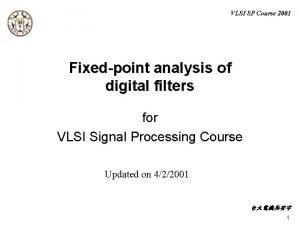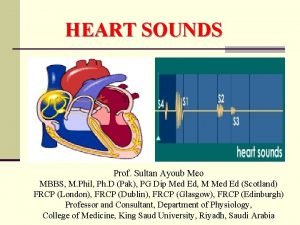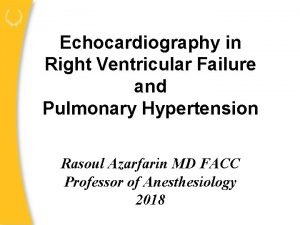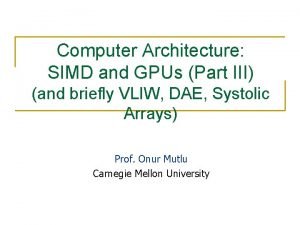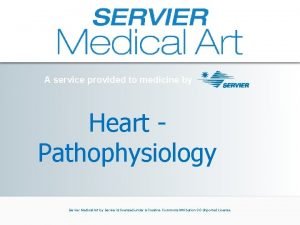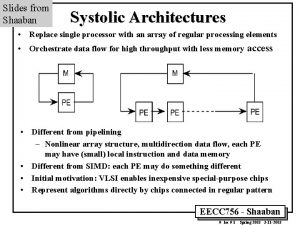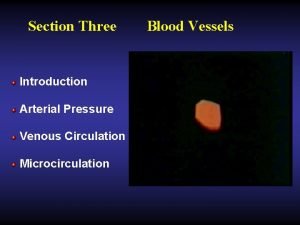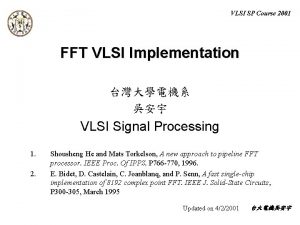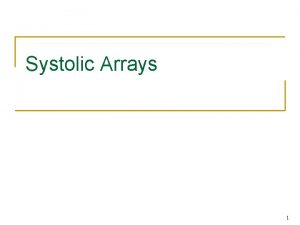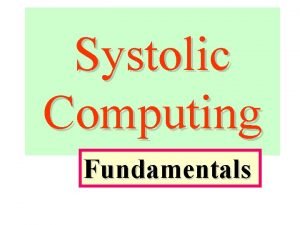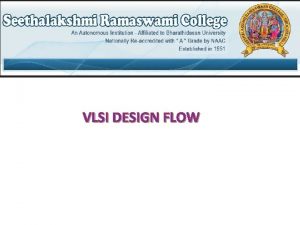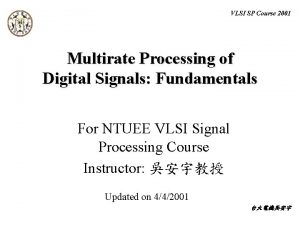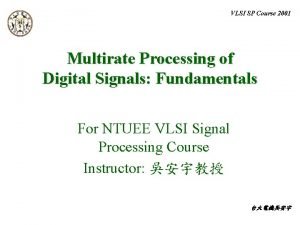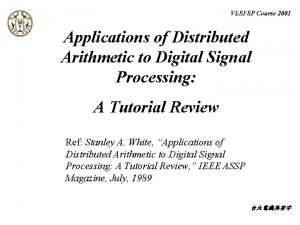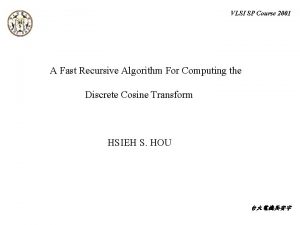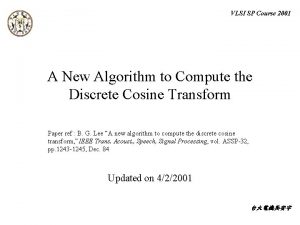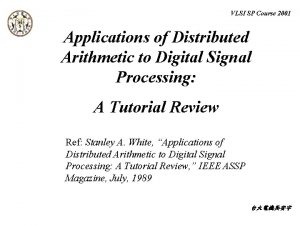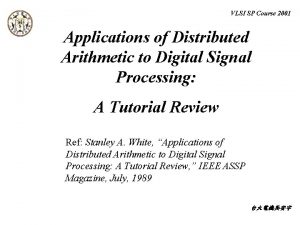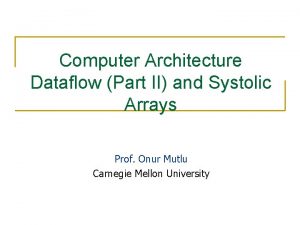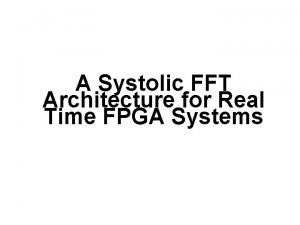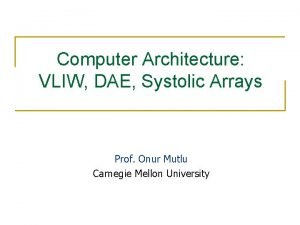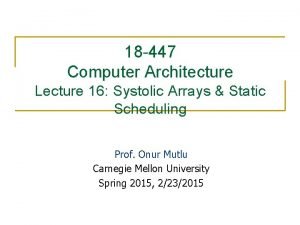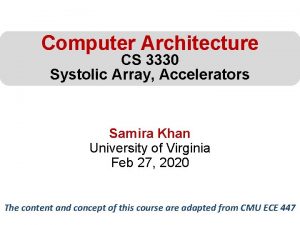VLSI SP Course 2001 Why Systolic Architecture H





















- Slides: 21

VLSI SP Course 2001 Why Systolic Architecture ? H. T. Kung Carnegie-Mellon University 台大電機吳安宇 1

VLSI SP Course 2001 Motivation & Introduction • We need a high-performance , special-purpose computer system to meet specific application. • I/O and computation imbalance is a notable problem. • The concept of Systolic architecture can map high-level computation into hardware structures. • Systolic system works like an automobile assembly line. • Systolic system is easy to implement because of it regularity and easy to reconfigure. • Systolic architecture can result in cost-effective , highperformance special-purpose systems for a wide range of problems. 台大電機吳安宇 2

VLSI SP Course 2001 Key architectural issues in designing special-purpose systems • Simple and regular design Simple , regular design yields cost-effective special systems. • Concurrency and communication Design algorithm to support high concurrency and meantime to employ only simple. • Balancing computation with I/O A special-purpose system should be match a variety of I/O bandwidth. 台大電機吳安宇 3

VLSI SP Course 2001 The basic principle of systolic architecture • Systolic system consists of a set interconnected cells , each capable of performing some simple operation. • Systolic approach can speed up a compute-bound computation in a relatively simple and inexpensive manner. • A systolic array in particular , is illustrated in next page. (we achieve higher computation throughput without increasing memory bandwidth) 台大電機吳安宇 4

VLSI SP Course 2001 Basic principle of a systolic system 台大電機吳安宇 5

VLSI SP Course 2001 A family of systolic designs for convolution computation • Given the sequence of weight {w 1 , w 2 , . . . , wk} • And the input sequence {x 1 , x 2 , . . . , xk} , • Compute the result sequence {y 1 , y 2 , . . . , yn+1 -k} • Defined by yi = w 1 xi + w 2 xi+1 +. . . + wk xi+k-1 台大電機吳安宇 6

VLSI SP Course 2001 Design B 1 • Previously propose for circuits to implement a pattern matching processor and for circuit to implement polynomial multiplication. Broadcast input , move results , weights stay [(Semi-) systolic convolution arrays with global data communication] 台大電機吳安宇 7

VLSI SP Course 2001 Design B 2 • The path for moving yi’s is wider then wi’s because of yi’s carry more bits then wi’s in numerical accuracy. • The use of multiplieraccumulators may also help increase precision of the result , since extra bit can be kept in these accumulators with modest cost. Broadcast input , move weights , results stay [(Semi-) systolic convolution arrays with global data communication] 台大電機吳安宇 8

VLSI SP Course 2001 Design F • When number of cell is large , the adder can be implemented as a pipelined adder tree to avoid large delay. • Design of this type using unbounded fan-in. Fan-in results , move inputs , weights stay [(Semi-) systolic convolution arrays with global data communication] 台大電機吳安宇 9

VLSI SP Course 2001 Design R 1 • Design R 1 has the advantage that it dose not require a bus , or any other global net-work, for collecting output from cells. • The basic ideal of this design has been used to implement a pattern matching chip. Results stay , inputs and weights move in opposite directions [(Pure-) systolic convolution arrays with global data communication] 台大電機吳安宇 10

VLSI SP Course 2001 Design R 2 • Multiplier-accumulator can be used effectively and so can tag bit method to signal the output of each cell. • Compared with R 1 , all cells work all the time when additional register in each cell to hold a w value. Results stay , inputs and weights move in the same direction but at different speeds [(Pure-) systolic convolution arrays with global data communication] 台大電機吳安宇 11

VLSI SP Course 2001 Design W 1 • This design is fundamental in the sense that it can be naturally extend to perform recursive filtering. • This design suffers the same drawback as R 1 , only approximately 1/2 cells work at any given time unless two independent computation are interleaved in the same array. Weights stay , inputs and results move in opposite direction [(Pure-) systolic convolution arrays with global data communication] 台大電機吳安宇 12

VLSI SP Course 2001 Design W 2 • This design lose one advantage of W 1 , the constant response time. • This design has been extended to implement 2 -D convolution , where high throughputs rather than fast response are of concern. Weights stay , inputs and results move in the same direction but at different speeds [(Pure-) systolic convolution arrays with global data communication] 台大電機吳安宇 13

VLSI SP Course 2001 Remarks • Designs Above are all possible systolic designs for the convolution problem. • Using a systolic control path , weight can be selected onthe-fly to implement interpolation or adaptive filtering. • We need to understand precisely the strengths and drawbacks of each design so that an appropriate design can be selected for a given environment. • For improving throughput , it may be worthwhile to implement multiplier and adder separately to allow overlapping of their execution. (Such as next page show) • When chip pin is considered , pure-systolic require four ; semi-systolic require three I/O ports. 台大電機吳安宇 14

VLSI SP Course 2001 Overlapping the executions of multiply and add in design W 1 台大電機吳安宇 15

VLSI SP Course 2001 Criteria and advantages • The design makes multiple use of each input data item Because of this property , systolic systems can achieve high throughputs with modest I/O bandwidths for outside communication. • The design uses extensive concurrency Concurrency can be obtained by pipelining the stages involved in the computation of each single result , by multiprocessing many results in parallel , or by both. 台大電機吳安宇 16

VLSI SP Course 2001 On-the-fly least-squares solutions using one and two dimensional systolic array , with p=4. 台大電機吳安宇 17

VLSI SP Course 2001 Criteria and advantages • There are only a few types of simple cells To achieve performance goals , a systolic system is likely to use a large number of cells which must be simple and of only a few types to curtail design and implementation cost. • Data and control flow are simple and regular Pure systolic system totally avoid long-distance or irregular wires for data communication. 台大電機吳安宇 18

VLSI SP Course 2001 Applications base on systolic array with convolution computation *Signal and image processing : • FTR , IIR filtering , and 1 -D convolution. • 2 -D convolution and correlation. • Discrete Fourier transform • Interpolation • 1 -D and 2 -D median filtering • Geometric warping 台大電機吳安宇 19

VLSI SP Course 2001 Applications base on systolic array with convolution computation *Matrix arithmetic : • Matrix-vector multiplication • Matrix-matrix multiplication • Matrix triangularization (solution of linear systems , matrix inversion) • QR decomposition (eigenvalue , least-square computation) • Solution of triangular linear systems 台大電機吳安宇 20

VLSI SP Course 2001 Applications base on systolic array with convolution computation Non-numeric applications : • Data structure • Graph algorithm • Language recognition • Dynamic programming • Encoder (polynomial division) • Relational data-base operations 台大電機吳安宇 21
 Why systolic architectures
Why systolic architectures Pictures
Pictures 2001 course
2001 course 2001 course
2001 course What is systolic blood pressure
What is systolic blood pressure Heart stroke volume
Heart stroke volume Stroke volume normal
Stroke volume normal Sam systolic anterior motion
Sam systolic anterior motion Heart sounds location
Heart sounds location S2 splitting
S2 splitting Elevated right ventricular systolic pressure
Elevated right ventricular systolic pressure Systolic over diastolic
Systolic over diastolic Systolic mm hg
Systolic mm hg Location of murmurs
Location of murmurs Systolic array vs simd
Systolic array vs simd Trunctus
Trunctus Systolic array
Systolic array Systolic presure
Systolic presure Isolated systolic hypertension
Isolated systolic hypertension What is systolic and diastolic pressure
What is systolic and diastolic pressure Dont ask
Dont ask Header bond t junction
Header bond t junction


